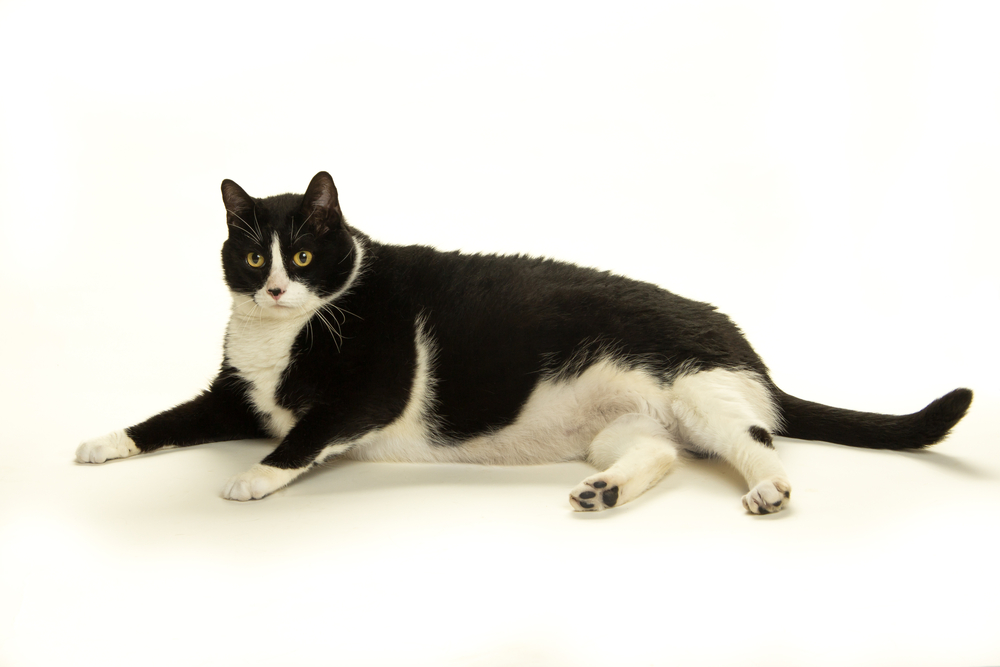Want your cat to be healthier, more active, live longer, and interact more with you? There is a “magic formula” for that—a healthy weight.
Fat cat memes are pretty funny, but feline obesity is no joke. Depending on which study you read, somewhere between 40 and 60 percent of housecats in the United States are obese—which is generally defined as weighing 20 percent or more above normal weight.
Weight, Health and Behavior
The health risks of obesity are serious. According to the American Association of Feline Practitioners (AAFP), being just two pounds above ideal body weight puts your cat at risk for respiratory disease, diabetes, high blood pressure, arthritis, fat deposits in the liver, heart disease, and some forms of cancer. Obesity can also be a risk factor for feline lower urinary tract disease (FLUTD). And excess fat tissue can be a source of constant stress and inflammation throughout the body.
Overweight cats also have trouble grooming, and may develop unkempt skin and fur, and those intractable hair tangles known as mats. They may need help to clean under their tail. Keeping clean is very important to cats, and not being able to properly groom is a real quality of life issue for such a fastidious creature.
What’s ideal body weight? Cats, like people, come in all sizes and body types, so what a healthy weight looks like will be different for different cats. Your veterinarian can tell you what’s right for your cat, but if you’re not sure a weight checkup is needed, you can start by looking at a body condition score chart (you can find one here). Basically, you should be able to feel but not see your cat’s ribs, see a bit of a waist when looking at your cat from above, and not see much of a fat flap when looking at your cat from below.
Being overweight affects your cat’s behavior as well as her health. A 2017 study comparing lean and overweight cats of similar ages showed that the lean cats were significantly more active than the overweight cats and also interacted more with their caretakers. The study measured how active the cats were on their own and also how much they initiated contact with their caretakers. So overweight cats aren’t just less active, they’re also less interactive.
Why Cats Gain Weight
Cats become overweight the same way we do—they eat more calories than they use up. Some cats stop eating when they’re not hungry, but not all. Some keep eating because they just like the food. Some cats, particularly those who have spent time finding food on their own, feel like they need to eat as much as they can all the time, because they may find themselves in situations again where there is no food.
Other factors play into obesity as well. Neutered cats tend to gain weight more easily because their metabolic rate goes down about 20 percent, so they need less food. And nutritionally speaking, a diet made up primarily of dry food is dense in calories.
There are behavioral factors, too. Some cats eat out of boredom; if there’s food around and there’s nothing else to do, they’ll eat. Sometimes cats ask for food when they’re not hungry, because when they ask we give them attention. And sometimes cats are just asking for attention, but we think they’re asking for food, so we feed them.
Weight Loss Tips
Cats also lose weight the same way we do—they eat fewer calories and exercise more. If you think it’s time to put your cat on a diet, talk to your veterinarian. Cats need to lose weight slowly. Rushing the process can lead to serious health problems because cats’ bodies are not designed to convert large amounts of stored fat. There are weight-loss veterinary diets that are high in protein, low in fat, and low in carbohydrates. But the truth is that feeding your cat more wet food, less dry food, and fewer calories overall, plus increasing her activity level, will help her to lose weight even without a veterinary diet.
As anyone who has ever gone on a diet knows, when you start eating less than you’re used to, you get hungry. The AAFP recommends frequent small meals for all cats, and that will certainly help your pudgy puss feel less hungry. Food puzzle toys will also force her to eat slowly, helping her move more and get more satisfaction from what she is eating. Grow some cat grass—because salad is good for all dieters! And that 2017 study found cats were naturally more active before mealtimes, so try playing with your cat for 10 or 15 minutes before you feed her.
But also think about how and when you pay attention to your cat. Is it only for meals? When she meows, do you just assume it’s a request for food? Think about whether you may have developed some food-focused habits, then consider how you might break them. If your cat follows you into the kitchen, offer her some interesting things she can smell (cooking herbs are a great nontoxic choice) instead of food. Keep a jar full of small toys on the counter and play a toss and chase game instead of a “bring forth the food” game. If you want to give her a few treats, make her work for them; toss them down the hallway or the stairs one by one.
Food is only one way to show your love. Keeping your cat at a healthy weight is another way.
This article was reviewed/edited by board-certified veterinary behaviorist Dr. Kenneth Martin and/or veterinary technician specialist in behavior Debbie Martin, LVT.








